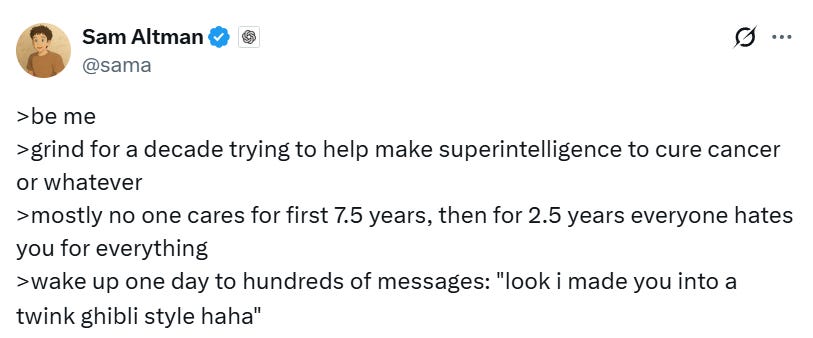OpenAI Plans to Add Erotica to ChatGPT But the Real Problem Is Less Sexy
As they say, digital technology eventually converges on porn
OpenAI CEO Sam Altman tweeted this, and people are losing their minds:
We made ChatGPT pretty restrictive to make sure we were being careful with mental health issues. We realize this made it less useful/enjoyable to many users who had no mental health problems, but given the seriousness of the issue we wanted to get this right.
Now that we have been able to mitigate the serious mental health issues and have new tools, we are going to be able to safely relax the restrictions in most cases.
In a few weeks, we plan to put out a new version of ChatGPT that allows people to have a personality that behaves more like what people liked about 4o (we hope it will be better!). If you want your ChatGPT to respond in a very human-like way, or use a ton of emoji, or act like a friend, ChatGPT should do it (but only if you want it, not because we are usage-maxxing).
In December, as we roll out age-gating more fully and as part of our “treat adult users like adults” principle, we will allow even more, like erotica for verified adults.
What this says, translated with a sort of Straussian reading, is that the mental health problems induced by ChatGPT were real, but OpenAI overdid the solution, and now it’s managed to create psychological profiles of users and know who is prone to be psychotic and who isn’t, and thus can reduce the restrictions for the latter group, but they will need some kind of age verification—sounds bad, whether it’s a guess or a literal ID requirement—to serve us a grown-up mode; that is, erotica, that is, porn.
People are panicking for various reasons, but above all, because they don’t think ChatGPT being used to write erotica is good.
Of course, that’s a weird thing to say on the internet, where every other site is a porn site. I mean, even the real world has been pornified. You have to make a conscious, constant effort not to be hit by a pair of tits every so often. It’s in ads, in social media, in TV shows, in the street. And now, also, in ChatGPT. But porn is not the real issue; allowing erotica chats is not why teenagers are addicted to porn and not having sex.
The problem, which I contend is what people actually complain about, is that PornHub never pretended to be saving humanity.
OpenAI’s mission is, presumably, to help all of humanity reach a new golden age of discovery and invention, and wellness. They want to “cure cancer or whatever,” for God’s sake! Just short of sainthood! But when you hear that they’re introducing adult mode, you immediately contrast that against their stated intentions: “Is this how you cure cancer?”
And that’s a totally natural and defensible thing to complain about! After all, the goodness of an enterprise is measured, just like human happiness, in what they do minus what they said they’d do, that is, reality minus expectations. If OpenAI promises to cure cancer and comes up, in a streak of fantastic launches, with in-app purchases in ChatGPT, emergent notifications, a short-form AI video zombification app (they call it Sora, which means “sky” in Japanese, although the app itself resembles jigoku better), and now porn—then it’s not surprising that people are confused and angry, and disappointed.
There’s only a certain amount of distasteful means one’s allowed to justify the greatest of ends. Beyond that, you become distasteful yourself. Just like people are not what they think they ought to be but what they are, a company like OpenAI is not what it says it will do, but what it actually does.
I’ve heard a few times already—and thought so myself—that this is not what a company pursuing artificial general intelligence (AGI) does. Yeah, I guess that’s a reasonable conclusion. But, to reveal the truth, I will have to disagree: this is exactly what a company pursuing AGI does—at least one that’s pursuing it by brute force rather than ingenuity.
OpenAI needs a lot of computing power to train new AI models and serve ChatGPT to 800 million people (more now that gooners will be using it 24/7). For that, they’re building datacenters and signing deals left and right with Nvidia, Oracle, AMD, Broadcom, to either get compute, get money, or get chips (now also designed by OpenAI itself!) They want to have available dozens of gigawatts by 2030. (To give you a reference, 1 gigawatt can power 750,000 US homes.)
But, how does OpenAI pay for all the stuff?
Keep reading with a 7-day free trial
Subscribe to The Algorithmic Bridge to keep reading this post and get 7 days of free access to the full post archives.


